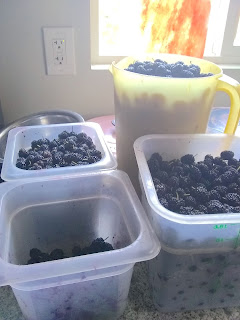 |
| grey skies and golden poppies |
I'm relishing the cold weather.
I can't remember if San Diego has ever had a winter like this one before. With consistently cold temps and steady rain for the past few months, many wild flowers, weeds, and volunteers have grown tall and green. Almost nothing is in bloom yet, except the native poppies.
That's not quite true: my lavender blooms year-round – much to the bees' delight – with aggressive dead-heading, the sour grass and arugula have both been flowering for weeks, and several plants are just starting to bloom: the purple splash climbing rose, nasturtiums, blackberries, and calla lilies. After no citrus this winter, the tangerines, calamansi, orange, and lemons are in blossom – the smell of neroli is heavenly.
The mulberry just started leafing out and our always-late loquats are thankfully growing little green fruits.
Plan
I've bought my seeds and I've been collecting materials to build supports for my tomatoes.
I'm researching
companion planting, especially for tomatoes (marigolds, calendula, green onion, chive, garlic, basil, carrots...) and chiles (basil, chives, carrots, leeks, oregano, parsley, marigolds...).
Prep
I'm prepping beds for tomatoes and corn. I'm harvesting the mulch and bedding from the chicken coop and yard for mulching the garden beds.
Weed
Now is the time - don't wait! The ground is soft and moist, making it easy to pull them and you probably want to pull them before they go to seed. Do it! Do it now!
Plant
Started many tomato seeds last month from
Baker's Creek but the seedlings are still too small to plant. Not to worry, as
Tomatomania is this month. Not only did they have the Gardener's Delight cherry tomato that did so well for us a couple years ago, but I got a few other new varieties to try:
- Spoon currant (a teeny tiny tomato)
- San Marzano Lungo paste (cuz I like to make the sauce)
- Madame Marmande beefsteak (I generally only plant heirlooms but I overheard a few people waxing poetic about this hybrid)
Actually, I probably went a little nuts with the seeds I bought, which is why I didn't buy too much at Tomatomania. Here's what I'm growing from seed:
These I've started indoors and will transplant sometime this or next month. The rest will be planted directly in the ground, mostly this month:
I'm continuing to work on a circular series of beds of mostly perennial herbs, but I'll also plant the peppers and the
3 sisters (corn, beans, squash/melon + amaranth & cosmos).
Also good to plant this month: radish, beets, broccoli, cabbage, lettuce, potatoes, greens, turnip, cucumber, squash, citrus, avocado, macadamia, dill, marjoram, mint, oregano, parsley, rosemary, sage, thyme, and the
last chance this year for natives.
Feed
Fertilize citrus, avo, orchids, 3# on passionfruit, everything (except natives and drought tolerant) in the waning moon.
Water
I'm grateful for continued rain!
Water deep in the morning every 10-14 days if it doesn't rain, more often for new seedlings. I'm blasting my fruit trees (that aren't flowering) with water a couple times this month to help control ants, aphids, white fly & scale.
Prune
I'm pinching off new growth on the grape vines below the trellis to concentrate the energy into the growth to cover the top of the trellis.
Here's what I'm harvesting...
eggs, arugula, nasturtiums, parsley, cilantro, thyme, garlic chives, lavender, lemon grass, rose geranium, lemon verbena, passion fruit
Here's my post from
March last year.





